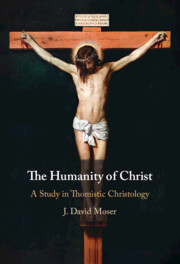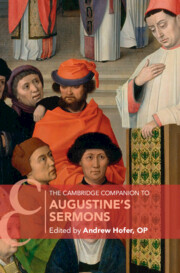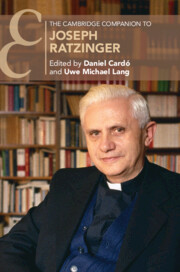Refine search
Actions for selected content:
101 results
17 - Liturgy and the Proclamation of the Word
- from Part IV - Liturgy and the Life of the Churches
-
-
- Book:
- The Cambridge Companion to Christian Liturgy
- Published online:
- 19 September 2025
- Print publication:
- 09 October 2025, pp 299-316
-
- Chapter
- Export citation
3 - Christology in the New Testament: Epistles and Revelation
- from Part I - The Christological Sources
-
-
- Book:
- The Cambridge Companion to Christology
- Published online:
- 15 September 2025
- Print publication:
- 02 October 2025, pp 45-59
-
- Chapter
- Export citation

The Cambridge Companion to Christian Liturgy
-
- Published online:
- 19 September 2025
- Print publication:
- 09 October 2025
1 - Scripture and Conciliar Teaching
- from Part I - Foundations and Statements of the Doctrine
-
- Book:
- The Humanity of Christ as Instrument of Salvation
- Published online:
- 21 August 2025
- Print publication:
- 04 September 2025, pp 15-30
-
- Chapter
- Export citation

The Humanity of Christ as Instrument of Salvation
- A Study in Thomistic Christology
-
- Published online:
- 21 August 2025
- Print publication:
- 04 September 2025

The Theology of the Letter to the Galatians
-
- Published online:
- 07 August 2025
- Print publication:
- 07 August 2025
Pusey, Scripture and Epistemology
-
- Journal:
- Journal of Anglican Studies , First View
- Published online by Cambridge University Press:
- 04 July 2025, pp. 1-9
-
- Article
- Export citation
10 - Preaching on the Trinity
- from Part III - Augustine’s Preaching Themes
-
-
- Book:
- The Cambridge Companion to Augustine's Sermons
- Published online:
- 26 May 2025
- Print publication:
- 12 June 2025, pp 193-208
-
- Chapter
- Export citation
4 - Sermons on the Old Testament
- from Part II - Augustine’s Sermons on the Scriptures and Liturgical Feasts
-
-
- Book:
- The Cambridge Companion to Augustine's Sermons
- Published online:
- 26 May 2025
- Print publication:
- 12 June 2025, pp 81-97
-
- Chapter
- Export citation

The Cambridge Companion to Augustine's Sermons
-
- Published online:
- 26 May 2025
- Print publication:
- 12 June 2025
6 - The Barren Fig Tree (Lk 13:6–9)
-
- Book:
- Luke's Unique Parables
- Published online:
- 28 February 2025
- Print publication:
- 06 March 2025, pp 65-70
-
- Chapter
- Export citation
1 - The Press toward the Authentic-Letter Perspective
-
- Book:
- The Letters of Paul in their Roman Literary Context
- Published online:
- 05 December 2024
- Print publication:
- 12 December 2024, pp 31-72
-
- Chapter
-
- You have access
- HTML
- Export citation
Primary Causality, Providence, and Scripture
-
- Journal:
- New Blackfriars / Volume 105 / Issue 6 / November 2024
- Published online by Cambridge University Press:
- 25 October 2024, pp. 610-620
- Print publication:
- November 2024
-
- Article
- Export citation
‘The Word of God taking up space’: Assessing the christological analogy for scripture
-
- Journal:
- Scottish Journal of Theology / Volume 77 / Issue 4 / November 2024
- Published online by Cambridge University Press:
- 22 May 2024, pp. 391-401
- Print publication:
- November 2024
-
- Article
- Export citation
Rowan Williams’ Theology of Revelation
-
- Journal:
- Journal of Anglican Studies , First View
- Published online by Cambridge University Press:
- 15 April 2024, pp. 1-10
-
- Article
- Export citation

The Cambridge Companion to Joseph Ratzinger
-
- Published online:
- 25 January 2024
- Print publication:
- 21 December 2023
36 - Ordering Emotional Communities: Modes of Knowing in Gregory the Great
-
-
- Book:
- The Intellectual World of Late Antique Christianity
- Published online:
- 05 October 2023
- Print publication:
- 26 October 2023, pp 690-704
-
- Chapter
- Export citation
6 - Origen’s Institutions and the Shape of Biblical Scholarship
-
-
- Book:
- The Intellectual World of Late Antique Christianity
- Published online:
- 05 October 2023
- Print publication:
- 26 October 2023, pp 100-117
-
- Chapter
- Export citation
Chapter 17 - The Feasts and Festivals of the Church, or Putting the Sabbath in Its Place
- from Holy Times
-
- Book:
- On Laudianism
- Published online:
- 05 October 2023
- Print publication:
- 19 October 2023, pp 221-234
-
- Chapter
- Export citation
Chapter 22 - A Religion of the Word and the Question of Authority
- from Part III - Laudianism: What It Wasn’t
-
- Book:
- On Laudianism
- Published online:
- 05 October 2023
- Print publication:
- 19 October 2023, pp 288-307
-
- Chapter
- Export citation
